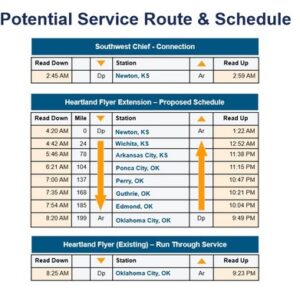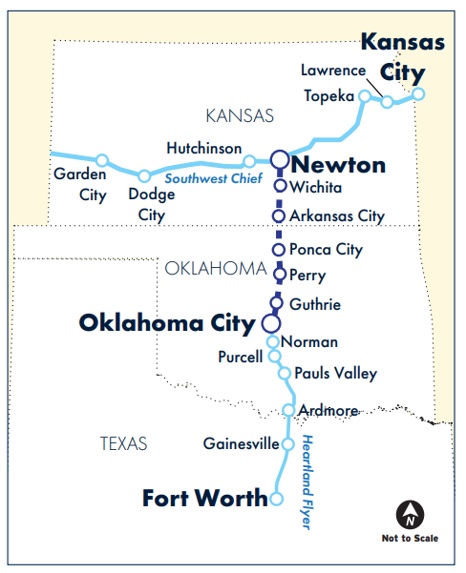Don’t schedule your trip just yet, but Amtrak passenger service appears closer to returning to Wichita for the first time since 1979.
The Federal Railroad Administration announced last month that an Oklahoma City-to-Newton route has been included in its corridor development program, which is guiding expansion of passenger train service. The agency allocated $500,00 to be used studying the extension of the Amtrak Heartland Flyer passenger route north from Oklahoma City. Wichita, Newton and Arkansas City would have stops, along with several cities in northern Oklahoma.
 From Oklahoma City, the Heartland Flyer extends south to Fort Worth, where there are connections available to Dallas and San Antonio via the Texas Eagle. In Newton it would connect with the Southwest Chief, which runs to Los Angeles, Kansas City and Chicago.
From Oklahoma City, the Heartland Flyer extends south to Fort Worth, where there are connections available to Dallas and San Antonio via the Texas Eagle. In Newton it would connect with the Southwest Chief, which runs to Los Angeles, Kansas City and Chicago.
Returning passenger train service to Wichita has been under study for decades. A similar expansion plan failed for lack of funding in 2011, but local business leaders and elected officials from Wichita to Washington, D.C., seem convinced that it will happen this time. The city last had passenger service in 1979, when Amtrak closed its Chicago-to-Houston line, known as the Lone Star.
“Getting the Federal Rail Administration’s blessing to move forward with our service plan for passenger rail from Newton to Oklahoma City and beyond is promising,” said state Sen. Carolyn McGinn, who represents parts of Sedgwick and Harvey counties.
John Rolfe, president and CEO of the Wichita Regional Chamber of Commerce, called it “a monumental step forward in making this project a reality,” and U.S. Sen. Jerry Moran said he was “pleased to see the first step in this corridor progress.”
Under current plans, the Heartland Flyer would run one daily round trip from Newton to Oklahoma City. The proposed schedule has the train leaving Newton at 4:20 a.m. in the morning, with a stop in Wichita at 4:42 a.m. and arrival in Oklahoma City at 8:20 a.m. The return route would depart Oklahoma City at 9:49 p.m., arriving at Wichita at 12:52 a.m. and Newton 30 minutes later.
According to a Kansas Department of Transportation study released last year, the 206-mile route could be operating by 2029 or even sooner if funding is fast-tracked.
In 2020, the project was estimated to cost about $124 million for modifications to the existing BNSF tracks, station improvements and rolling stock. Funds would come from a combination of federal and state sources.
The KDOT study projects that the train would be more likely used by college students and people over 65 and also prove attractive for low-income households and people with disabilities. The route would provide communities along the route better access to airports in Wichita and Oklahoma City, spur economic development and tourism and reduce pollution, the study said. One-way tickets woud probably be priced around $50 or less.
The FRA’s corridor development plan was part of the bipartisan, $1.2 trillion Bipartisan Infrastructure Law by President Biden in 2021. There’s sure to be competition for the funds, as the first round of corridor development has identified nearly 70 routes for expansion or improvement.









